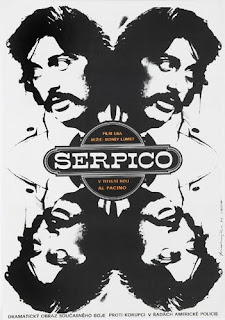>Why do people think that just because you give voice to one opinion of one political party, you’re down 100% with that specific party? Just a disclaimer, because I’m not down with any party. So therefore, here’s some old school communism for ya, the way I like it: classy! Because if there’s gonna be a class war, I’d like it classy…
All posts by Indy
>Modern film posters
>Yes, modern film posters are ugly as hell. I guess that’s representative for shallow and soulless lives lead by bastards who want everything served on a silver platter. This is beyond doubt the age of stupid in every possible way. People are lazy fucks. People are stupid fucks. I could continue on…
However, there are of course some people who defy the laws of tradition (Primus pun intended – check the jam here, its’ awesome!) and create what in my mind is good looking shit.
Here are some posters and designs created by allcity. They would be even better looking without the ugly review quotes, but this is about as clean as it gets, and that’s the way I like it. The unused ones are in my opinion way better than the ones that were chosen in the end.
It’s all a matter of taste…
>Czech film posters
>
Malleus

Stolen text from the Czech Film Posters website:
“Following a communist take-over in 1948, Czechoslovakia was ruled by a totalitarian regime for over forty years. The level of oppression varied throughout the period – the stifling Stalinist practices of the 1950s gradually gave way to a more liberal rule in the 1960s. But the 1968 Prague Spring movement to break free from the leash held by the Kremlin was brutally supressed by the Red Army in August. The following period of darkness – referred to by the regime as “the process of normalisation” – gradually lightened with the onset of Gorbachev’s Perestrojka in the mid 1980s. Like most other Central European communist regimes the Czech one fell in 1989 during the wave of changes set off by the powerfully symbolic fall of the Berlin Wall.
The attitudes of the censors rode the same waves as the regime in general.
[…]
[…]
>The Israel Lobby – A letter from John Mearsheimer
>  I got a letter from John Mearsheimer the other day. I opened and read it, it said they were suckers.
I got a letter from John Mearsheimer the other day. I opened and read it, it said they were suckers.
Well, he didn’t say that, really, but he enclosed a speech he gave in Norway recently, and the finishing words read as follows:
“The bottom line is straightforward: President Obama is not going to be able to push Israel to accept a two-state solution. Instead, Israel will continue to colonize the West Bank and eventually turn itself into an apartheid state. Given that grim future, the Israelis are likely to think more and more about expelling the Palestinians from their midst, as they have done in the past. All of this is to say that Netanyahu’s recent victory over Obama was no victory at all. On the contrary, it means that there will be big trouble ahead for Israel, the United States, and especially the Palestinians.“
John Mearsheimer, October 5 2009, Oslo, Norway
I’ll return to John’s speech and letter as soon as possible.
To be able to communicate with the author of the book I’m reading and obviously using as source for these articles is amazing. Hail the internet, freedom of speech and a true and honest debate above all.
Read more about John Mearsheimer.
>The Israel Lobby – The cash
>
No words can express our gratitude for your generous support, understanding, and cooperation, which are beyond compare in modern history.
Israeli Prime Minister Yitzhak Rabin, 1994
We’re both born of struggle and sacrifice. We’re both founded by immigrants escaping religious persecution in other lands. We have both built vibrant democracies, built on the rule of law and market economies. And we’re both countries founded on certain basic beliefs: that God watches over the affairs of men, and values every life. These ties have made us natural allies, and these ties will never be broken.
George W. Bush, American Israel Public Affairs Committee speech, 2004
And I know that when I visit AIPAC I’m among friends, good friends… friends who share my strong commitment to make sure that the bond between the United States and Israel is unbreakable today, unbreakable tomorrow, unbreakable forever.
Barack Obama, AIPAC speech, 2008. Hardly watchable here.
Yitzhak, you’re completely right. U.S. support to Israel pale in comparison.
George, do you think God is proud of what you’re doing? And what’s this bullshit about He who values every life? Whitey, please… Say that to the millions of people you have killed, and the billions of people whose lives your country has ruined over the years.
Barack, your ass kissing is disgusting, and in return you’ll be the most ass-kissed president in U.S. history. What an anal orgasm, huh? Peace, bro!
But seriously, even if Israel had been a poor country, the level of material, economic, military and diplomatic support that the United States provides would have been remarkable. By 2004, Israel, a comparatively small country, had become the world’s eighth largest arm supplier. It is a without a doubt a powerful modern industrial state.
As of 2005, direct U.S. economic and military assistance to Israel amounted to 154 billion dollars. Nowadays Israel receives about three billion dollars per year in direct foreign assistance. These are not loans. They’re grants. Also, Israel is the only country that doesn’t have to account for how the foreign aid is spent. Aid to other countries are given for specific purposes, like children’s health, improving education, etc., but Israel receives a direct cash transfer and there is no way to tell how Israel uses U.S. aid.
In addition to all this craziness, Israel, again as the only country, receives its total cash transfer in the first days of the year, while other countries get their cash in quarterly installments. To make such a huge cash transfer possible, U.S. government needs to borrow the money up front, and it’s estimated that it costs U.S. taxpayers between 50 and 60 million dollars per year to borrow funds for this early year payment.
When given money from the United States as military assistance, countries are normally required to spend the money in the U.S. to help keep American defense workers employed (i.e. to buy U.S. weaponry). This is not the case when it comes to Israel. According to a special exception in some crazy ass bill, Israel is allowed to use about one out of every four dollars on its own defense industry.
However, during the 1950’s, economic aid to Israel was quite modest, and the U.S. did not provide much military assistance at all. It was the Kennedy administration that made the first commitment by selling U.S. Hawk antiaircraft missiles to Israel in 1963. This sale opened up for more weapon deals, most notably the sale of more than two hundred M48A battle tanks in 1964. To disguise American involvement and avoid anger from the Arab world, the tanks were shipped to Israel by West Germany…
Between 1966 and 1970 economic aid was at 102 million dollars per year. In 1971 that support sum was raised to 634.5 million dollars, and after the Yom Kippur War in 1973, economic aid more than quintupled (five times the size!). In 1976 Israel became the largest annual recipient of U.S. foreign assistance, a position it has retained ever since.
Three billion dollars per year is hardly the whole story, though. The actual total is much higher, since Israel is given money under unusually favorable terms, and the U.S. also provides Israel with lots of other material assistance that is not included in the foreign assistance budget.
America allows Israel, and only Israel, to borrow money from commercial banks at very low interest rates. For example, in the early 1990’s Israel received ten billion dollars to finance the costs of settling Soviet Jews immigrating to Israel.
As for private donations, every year Israel recieves about two billion dollars from American citizens. According to John Mearsheimer and Stephen Walt, authors of The Israel Lobby and U.S. Foreign Policy, one recent (2006) dinner in New York raised 18 millions dollars in private contributions, money which is tax deductible under U.S. law.
Also, the aid that the U.S. provides to Israel’s neighbours – particularly Egypt and Jordan – is at least partly intended to benefit Israel as well. The cash is rewards for good behavior, like when these countries sign peace treaties with Israel. In 1979, when the Egypt-Israeli peace treaty was signed, U.S. aid to Egypt reached 5.9 billion dollars. When King Hussein of Jordan signed a peace treaty in 1994, Jordan’s 700 million dollar debt to America was erased. These are just a couple of examples of Washington’s generosity toward the Jewish state.
Mearsheimer and Walt are constantly being accused of anti-Semitism because of their book. They’ve discussed pretty much each and every accusation in a 73 page long PDF document entitled Setting the Record Straight – A Response to Critics of “The Israel Lobby”.
Read it in case you’re in doubt.
Part One in this series.
An introductory video to the Israel lobby.
The photos they don’t want you to see.
>The Israel Lobby – What it is
>
Because the United States is a nation of immigrants it has created a great number of interest groups who obviously work for their own ethnic good. Cuban Americans have lobbied to maintain the embargo on Castro’s regime, for example. The Israel lobby works the same way. There’s nothing strange about that.
However, the Israel lobby has convinced many Americans and people world wide that American interests and Israeli interests are identical. They surely are not. Just by making an open debate impossible (you’re immediately labelled the Jew Hater and the evil Anti-Semite, whenever you try to discuss these subjects (the amount of anonymous emails I’ve recieved since I started this blog is pretty interesting…)) Israel and the Zionist idea encourages anti-Semitism – and with that comes the anti-American vibe. Hence, their policy is simply contraproductive. Anyone should be able to see that, really.
So the strange thing here is the very special relationship between Israel and the United States.
So what is the Israel lobby? It is ”a loose coalition of individuals and groups – not a single, unified movement with a central leadership – that seeks to influence American foreign policy in ways that will benefit Israel”, as defined by John Mearsheimer and Stephen Walt, authors of The Israel Lobby and U.S. Foreign Policy.
And the political power of the Israel lobby is p.o.w.e.r.f.u.l. as hell, I kid you not.
Any politician in the United States who challenges Israel policy stands little chance of becoming president. That’s plain fact. Democrats and Republicans alike fear the lobby, which is totally obvious. The presidential candidates may argue and disagree on whatever important issue facing the United States, but they all agree firmly on one specific subject: their deep personal commitment to one foreign country – Israel. The candidates are all too willing to criticize many of the things that other countries do, but they never criticize Israel.
Click here for President Obama’s AIPAC speech, just to pick a recent example.
Why does Israel, and no other country in the world, recieve such consistent support from America’s leading politicians? No matter what Israel does, the level of support remains unchanged. Almost every country in the world criticized Israel’s bombing campaign in Lebanon 2006 (and in Gaza 2008/2009) – but the United States did not. Instead they endorsed the war.
This is all thanks to the political power of the Israel lobby.
If you think this is a conspiracy theory, the conspiratory fool is definitely you.
So why the constant bitching about anti-Semitism? Because the lobby’s arguments are so terribly weak. That’s why their only choice is to marginalize serious discussion. That’s why they always play the Holocaust card. In fact, there’s a huge gap between what the broader public thinks about the Israeli/American relationship and how governing elites in Washington conduct American policy. If the American public and the world could be involved in serious debates about Israel they would be even more aware of the lobby’s huge influence and how it destroys American interests – and in the long run, Israeli interests as well. And in an even longer run – which is not that far away – the slow and painful annihilation of the Earth. However, open debate is non-existent.
The main reason for this gap is – yes, you guessed it – the political power of the Israel lobby. We all know how the mass media work. Noam Chomsky influenced me to spit it out like this, and he’s a Jew, you know:
(Correction: he’s a self-hating Jew, according to the Israel lobby…)
Fucked by the mainstream – Part 1
Fucked by the mainstream – Part 2
Fucked by the mainstream – Part 3
Fucked by the mainstream – Part 4
And here are the photos they don’t want you to see:
Gaza massacre 2008/2009
This is what the Nobel Peace Prize is all about.
To be continued in Part Two where we deal with America’s economic aid to the Holy Land.
>War is peace? Nigga please!
>
The Nobel Peace Prize is such a bad, repulsive joke. Somebody, please: end all life now. And that’s not a joke.








































